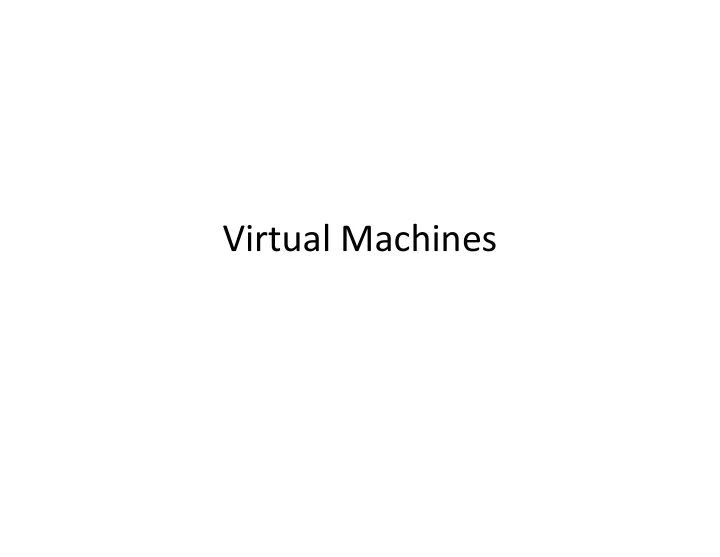

Virtual Machines
Virtual Machines • What is a virtual machine? • Examples? • Benefits?
Virtualization • Creation of an isomorphism that maps a virtual guest system to a real host: – Maps guest state S to host state V(S) – For any sequence of operations on the guest that changes guest state S1 to S2, there is a sequence of operations on the host that maps state V(S1) to V(S2)
Important Interfaces • Application programmer interface (API): – High-level language library such as clib • Application binary interface (ABI): – User instructions (User ISA) – System calls • Hardware-software interface: – Instruction set architecture (ISA)
What’s a Machine? • Machine is an entity that provides an interface – Language view: • Machine = Entity that provides the API (language) – Process view: • Machine = Entity that provides the ABI – Operating system view: • Machine = Entity that provides the ISA
What’s a Virtual Machine? • Virtual machine is an entity that emulates a guest interface on top of a host machine – Language view: • Virtual machine = Entity that emulates an API (e.g., JAVA) on top of another • Virtualizing software = compiler/interpreter – Process view: • Machine = Entity that emulates an ABI on top of another • Virtualizing software = runtime – Operating system view: • Machine = Entity that emulates an ISA • Virtualizing software = virtual machine monitor (VMM)
Purpose of a Virtual Machine
Purpose of a Virtual Machine • Emulation – Create the illusion of having one type of machine on top of another • Replication – Create the illusion of multiple independent smaller guest machines on top of one host machine (e.g., for security/isolation, or scalability/sharing) • Optimization – Optimize a generic guest interface for one type of host
Types of Virtual Machines • Emulate (ISA/ABI/API) for purposes of (Emulation/Replication/Optimization) on top of (the same/different) one.
Types of Virtual Machines • Emulate (ISA/ABI/API) for purposes of (Emulation/Replication/Optimization) on top of (the same/different) one. – Process/language virtual machines (emulate ABI/API) – System virtual machines (emulate ISA)
Types of Virtual Machines • Emulate (ISA/ABI/API) for purposes of (Emulation/Replication/Optimization) on top of (the same/different) one. – Process/language virtual machines (emulate ABI/API) – System virtual machines (emulate ISA)
Example 1 - Multiprogramming • Emulate what interface? • For what purpose? • On top of what?
Example 1 - Multiprogramming • Emulate the ABI (user ISA + OS system calls) • For purposes of replication (multiple processes share a physical machine) • On top of the same ISA/OS
Example 2: Emulation • Emulate one ABI on top of another – Emulate a Intel IA-32 running Windows on top of PowerPC running MacOS (i.e., run a process compiled for IA-32/Windows on PowerPC/MacOS) • Interpreters: Pick one guest instruction at a time, update (simulated) host state using a set of host instructions • Binary translation: Do the translation in one step, not one line at a time. Run the translated binary
Writing an Emulator • Create a simulator data structure to represent: – Guest memory • Guest stack • Guest heap – Guest registers • Inspect each binary instruction (machine instruction or system call) – Update the data structures to reflect the effect of the instruction
Example 3: Binary Optimization • Emulate one ABI on top of itself for purposes of optimization – Run the process binary, collect profiling data, then implement it more efficiently on top of the same machine/OS interface.
Example 4: Language Virtual Machines • Emulate one API on top of a set of different ABIs – Compile guest API to intermediate form (e.g., JAVA source to JAVA bytecode) – Interpret the bytecode on top of different host ABIs • Examples: – JAVA – Microsoft Common Language Infrastructure (CLI), the foundation of .NET
Types of Virtual Machines • Emulate (ISA/ABI/API) for purposes of (Emulation/Replication/Optimization) on top of (the same/different) one. – Process/language virtual machines (emulate ABI/API) – System virtual machines (emulate ISA)
Types of Virtual Machines • Emulate (ISA/ABI/API) for purposes of (Emulation/Replication/Optimization) on top of (the same/different) one. – Process/language virtual machines (emulate ABI/API) – System virtual machines (emulate ISA)
System Virtual Machines (Conventional – Same ISA) • Implement VMM (ISA emulation) on bare hardware – Efficient – Must wipe out current operating system to install – Must support drivers for VMM • Implement VMM on top of a host OS (Hosted VM) – Less efficient – Easy to install on top of host OS – Leverages host OS drivers
Whole System Virtual Machines • Emulate one ISA on top of another – Typically runs on top of host OS (e.g., install Windows compiled for IA-32 on top of MacOS running on PowerPC) – Note: this is different from a process virtual machine that emulates the Windows interface and user IA-32 instructions on top of MacOS running on PowerPC
Taxonomy • Process VMs – Same ISA • Multiprogrammed systems – Different ISA • Dynamic translators (Java), emulators • System VMs – Same ISA • Classic VMs • Hosted VMs (VMWare) – Different ISA • Whole system VMs
Emulation • Problem: Emulate guest ISA on host ISA
Emulation • Problem: Emulate guest ISA on host ISA • Solution: Basic Interpretation inst = code (PC) opcode = extract_opcode (inst) switch (opcode) { case opcode1 : call emulate_opcode1 () case opcode2 : call emulate_opcode2 () … }
Emulation • Problem: Emulate guest ISA on host ISA • Solution: Basic Interpretation new inst = code (PC) opcode = extract_opcode (inst) routineCase = dispatch (opcode) jump routineCase … routineCase call routine_address jump new
Threaded Interpretation [ body of emulate_opcode1 ] inst = code (PC) opcode = extract_opcode (inst) routine_address = dispatch (opcode) jump routine_address [ body of emulate_opcode2] inst = code (PC) opcode = extract_opcode (inst) routine_address = dispatch (opcode) jump routine_address
Recommend
More recommend